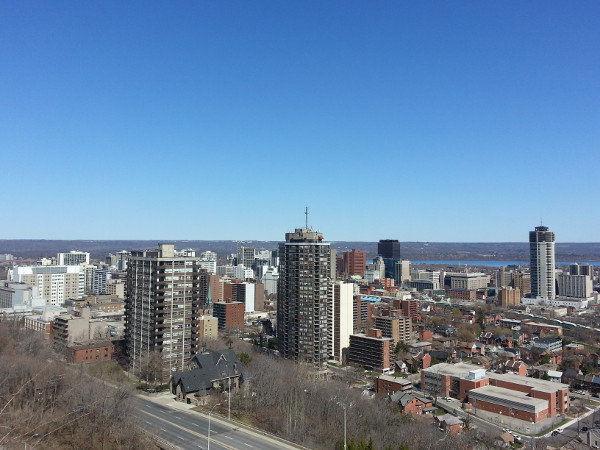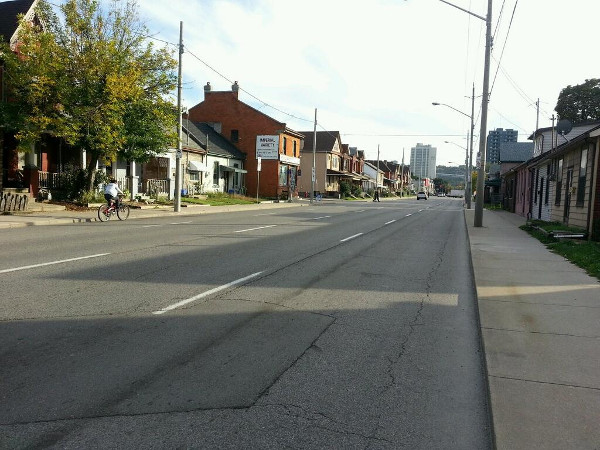As downtown has undergone a revival, Council has lost its sense of urgency and now refuses to follow through on the revitalization initiatives it started in the late 1990s and early 2000s.
By Ryan McGreal
Published April 27, 2015
Notes from my presentation to the Hamiltime! urbanist tour of Hamilton on Saturday, April 25. I met the tour at Sam Lawrence Park around 11:30 AM.

Downtown Hamilton, view from Sam Lawrence Park
Hamilton is a city that has long been caught in the trap of an economic monoculture, a trap of our own making. We grew up with a relatively small number of large industrial employers, which provided an upstream market of suppliers, a large pool of well-paying jobs for skilled, semi-skilled and unskilled workers, and big industrial property tax revenues for the City.
Over the past 30 years, globalization and automation have eliminated most of those large employers, their jobs and their property tax revenues. Despite the global trajectory of changes, Hamilton remains substantially stuck in rust-belt thinking.
To this day, our economic development strategy leans heavily on servicing industrial greenfields next to highways and the airport to lure companies here with big discounts and subsidies.
This approach tends to attract bottom-feeding companies looking to consolidate their operations and minimize their costs, rather than visionary companies looking to maximize their value. If they come here at all, it is because we're the cheapest place to operate, and if another city undercuts us, they'll leave without a second thought.
We are mostly failing to cultivate our potential to foster an urban environment that supports starting and growing new local made-in-Hamilton companies.
We are not acting on the economic research that cities are natural engines of economic development - that the essential economies of density, scale, agglomeration and association are drivers of innovation and growth.
Our legacy of rust-belt thinking also manifests in our one-way street network, which was designed in the 1950s for an army of workers driving to the industrial north end and persists today despite all evidence that it has long outlived whatever limited utility it may once have provided.

Wellington Street North during rush hour (RTH file photo)
Multi-lane thoroughfares that were designed to carry 30-40,000 cars a day now carry less than 10,000. They run past people's homes and through their neighbourhoods, deterring the kinds of chance encounters that enrich our lives even as they produce new ideas.
Our rust-belt street network hurts our ability to offer a high quality of life in urban neighbourhoods for those people who seek it. It hurts our ability to attract and retain creative professionals and entrepreneurs. It hurts our ability to provide safe, livable, inclusive streets for everyone.
It persists against all the obvious harm it causes because it continues to serve the narrow interests of people who simply want to drive through the city quickly and easily. This, in turn, plays into an urban/suburban dynamic that Torontonians will find very familiar
The good news is that things have been changing, albeit slowly.
In the 1990s, a broad, citizen-driven visioning and planning exercise called Vision 2020 produced a set of ideas to steer Hamilton toward a more hopeful, more sustainable future.
This was a time when the state of the lower city and downtown core was truly dismal. The fear that Hamilton could follow the footsteps of American cities like Detroit and Buffalo into collapse spurred Council into a sense of urgency. They were persuaded to adopt some of the initiatives from the Vision 2020 exercise that have paved the way for the revival that is currently underway.
They agreed to convert a few key streets to two-way, including James and John. At the time, the streets were widely regarded as too far gone to save. Over the past decade, James Street North has gone from the poster child for urban disinvestment to the model of urban revitalization.
They eliminated development charges for new downtown projects. This makes sense since the infrastructure for infill projects is by definition already in place.
They established a downtown Residential Loan Program to bridge the financing gap for new residential projects. Money has been loaned out, repaid and loaned again in this successful program.
It also helps that Hamilton is just close enough to Toronto to be a potential escape hatch for people being priced out of that red-hot market.
In addition, Hamilton is arguably the only authentically urban rather than suburban municipality in the GTHA other than Toronto - a real mid-sized city with a coherent, intact urban form and a more human scale.
The problem is that as downtown has undergone a revival, Council has lost its sense of urgency and now refuses to follow through on the revitalization initiatives it started in the late 1990s and early 2000s.
Two-way conversions that were approved in 2001 languish year after year without funding and attempts to make modest investments in increased livability that will pay huge net returns are met with resentment and divisive politicking.
Now, as in the 1990s, the push for change must come, and is coming, from the bottom up, not from the top down. Engaged citizens and groups in Hamilton need to get better at organizing to cooperate and build support. We need to get better at explaining how a healthy centre benefits the whole city.
We need to align the interests of urban and suburban residents and find ways to neutralize the negative effects of wedge politics. We don't have a high-profile Rob Ford type here, but the same dynamics are definitely in play.
We need to get better at integrating the fresh perspectives and ideas of people choosing to move to Hamilton from other places - places from which we can learn lessons to apply in our own ongoing revival.
We need to figure out how to let go of our destructive legacy of rust-belt thinking once and for all. I hope events like Hamiltime can help us with that.
By bvbborussia (registered) | Posted April 27, 2015 at 14:10:38
Good perspective. Too often I am forced to think that Hamilton's recent revival is happening in spite of our civic leaders and not as a result of their efforts. We're on the cusp of something great as a city but self-interest and short sighted thinking on the part of leaders threatens to stunt all the good work that's been done.
By beancounter (registered) | Posted April 28, 2015 at 09:51:37
Looks like a Freudian slip in the second main paragraph: "Our rust-best street network...".
A magnificent summary of the strength and persistence of 50's thinking in this city, otherwise.
By asingh (registered) | Posted April 28, 2015 at 10:17:08
Couldn't agree more we need to commit to the sense of urgency that revitalized Hamilton in the 1990s. That effort must come from bottom up from engaged citizens. Wedge politics has kept Council from making progressive, intelligent and forward-thinking decisions. For that we need to hold Council to task, since their ethical duty is to act for the best of all citizens of the City of Hamilton, not just those that live in their Ward.
One minor typo in paragraph 4 "If they come here it all" should probably read "If they come here at all."
By ItJustIs (registered) | Posted April 28, 2015 at 10:35:29
I think that so many actively concerned people...including respected thinkers such as Herman Turkstra, whose nice recent Spec piece paraded out Yesteryear Downtown Hamilton...need to, once-and-for-all, be given the opportunity to really, genuinely understand the past hundred years. Because what I tend to see, read or hear on the subject is reactionary, revisionary, lacking authentic perspective and context, and, though it might not be overtly offered, damning of not only the practices, but the Hamiltonians who were responsible for so much that's railed against.
Most especially, a thorough examination as to the various Councils' decisions over the past three decades and the reasons behind them is due, if only to ground the dialogue a little more in mature reality than in painting with a consistently broad brush.
Otherwise, all we end up with is an endless parade of earnest jingoism which, sadly, only tends to accentuate polarization in Hamilton.
Just sayin'...
Comment edited by ItJustIs on 2015-04-28 10:36:39
By justisnt (anonymous) | Posted April 28, 2015 at 11:16:06 in reply to Comment 111132
Wow, how do you always say a lot without actually saying anything, not anything important anyway.
By duped (anonymous) | Posted April 28, 2015 at 11:16:54 in reply to Comment 111132
Thanks for wasting seconds of my life reading your comment that I won't ever get back.
By Cultosaurus (registered) | Posted April 28, 2015 at 11:44:56 in reply to Comment 111132
Just sayin' ... not much of anything ...
By bvbborussia (registered) | Posted April 28, 2015 at 17:55:14 in reply to Comment 111141
Every other city in North America is seeing a slow resurgence?
By WithUsAlways (anonymous) | Posted April 28, 2015 at 19:28:40
What about the disenfranchised? This rising river does not float all boats. Looks like no inclusive zoning exists.
By Cultosaurus (registered) | Posted April 28, 2015 at 21:35:15 in reply to Comment 111141
Stop being so obtuse. Ryan's article is not just about one-way to two-way conversions, they are just used as an example of council foot-dragging. You could write another, similar article about LRT, or bike lanes or traffic calming with the same essential point - the sense of urgency has been lost and council is once again becoming myopic and complacent.
By ItJustIs (registered) | Posted April 29, 2015 at 11:49:34
Comment edited by ItJustIs on 2015-04-29 11:50:24
By bvb too (anonymous) | Posted May 01, 2015 at 14:10:21 in reply to Comment 111112
nice win over bayern
By kevlahan (registered) | Posted May 01, 2015 at 14:24:26 in reply to Comment 111197
Uh, I always thought that "The Hammer" was a fairly recent ironic and lighthearted innovation ... an alternative to the unoriginal and now largely inappropriate "steel town".
Can you point to any use of "the Hammer" before 15 years ago? Certainly not 40 years ago.
The "ambitious city" is an even older nickname, again a bit ironic as it was originally a Toronto put-down. Unfortunately, it's a bit ridiculous to try to revive it today (as some have), except in a sort of aspirational way.
You must be logged in to comment.
There are no upcoming events right now.
Why not post one?